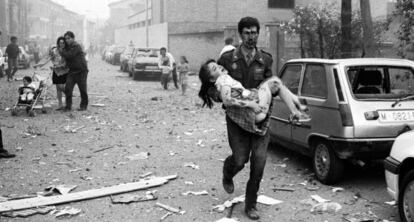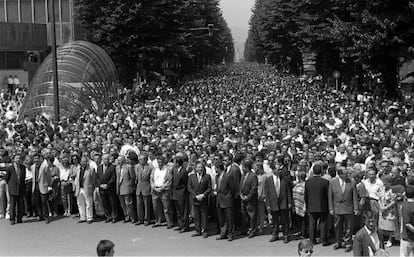There was no Basque conflict, just ETA totalitarianism
Historians’ report commissioned by regional government debunks terrorist group's claim


A team of historians hired by the Basque government to analyze the years of terrorism in the region has concluded that there was never a two-sided conflict, as ETA always alleged, simply an attempt by the Basque armed group to impose its totalitarian project on a society that was fast embracing democracy.
The findings come after a year of research by four experts from the University of the Basque Country’s Valentín de Foronda Institute for Social History Studies.
The 100-plus-page report by Raúl López Romo, Luis Castells, Antonio Ribera and José Antonio Pérez comes in the middle of a public debate in which much of Basque society is demanding that the abertzale – the left-wing forces that traditionally supported ETA’s actions – finally admit the suffering caused by the terrorist group.
So far, ETA and its supporters have avoided taking any responsibility for the decades of bombings, shootings and financial extortion by depicting the situation in the Basque Country as “a conflict” between itself and the state that resulted in victims on both sides of the divide. Northern Ireland has often been invoked as a similar case.
But co-author López Romo underscores that, unlike Northern Ireland, “the Basque Country did not have two terrorist groups confronting one another and enjoying similar levels of social support. Over here, there was just one terrorist group, ETA, which had significant support at street level. The paramilitary groups did not have any social support and their activity, while equally condemnable, was much smaller and short-lived.”
The historians’ report notes that of the 914 fatal victims of terrorism during the period under scrutiny – 1968 to 2010, coinciding with ETA’s first and last attack – 845 were killed by ETA, representing 92 percent of the total. Another 62 people, or seven percent, were assassinated by paramilitary or far-right groups such as GAL, the state-sponsored unit that fought a dirty war against ETA between 1983 and 1987. Another seven individuals were killed by unknown parties.
Unlike Northern Ireland, the Basque Country did not have two terrorist groups confronting one another and enjoying similar levels of social support”
Historian Raúl López Romo
“One cannot turn the page using the argument that we need to look forward,” said another of the report’s authors, Luis Castells. “Before forgetting, it is necessary to clear up the why of terrorism and its totalitarian pretenses, with the wellbeing of future generations in mind.”
Another revealing statistic to emerge from the study is that between 1968 and 1975, when Spain was still under Francoist rule, ETA only killed five percent of its total victims. Most of its criminal activity took place during the Transition and the consolidation of democracy, between 1976 and 1994, when ETA caused 771 deaths. Between 1995 and 2010, there were 98 killings.
The worst year was 1980, when the Basque Country got its own regional parliament. The second-worst was 1979, when the region obtained its charter of rights, the Estatuto de Gernika.
Historians posit that ETA’s chief goal was to destabilize democracy in Spain and regional autonomy in the Basque Country before it took hold, in order to impose its own Marxist-inspired vision.

“After the end of Franco’s dictatorship, the main perpetrator of terrorist attacks was ETA,” notes López Romo. “ETA marked the beginning and the end of terrorism.”
The report establishes a historical turning point in 1997, when ETA kidnapped and murdered a young Popular Party (PP) councilor, Miguel Ángel Blanco, after publicly announcing its intentions if its demands were not met.
This particular murder galvanized Basque society into more openly rejecting ETA’s so-called conflict. Opinion surveys showed social support for ETA falling from 20 percent in 1995 to three percent in 2007.
The report also shows that ETA mostly targeted politicians from the center-right PP, followed by businesspeople, Socialist politicians, judges, police officers, military personnel and lawyers.
Another new piece of information is the total number of people injured in terrorist attacks over the period: 2,533, of whom 709 sustained serious or permanent injuries.
Tu suscripción se está usando en otro dispositivo
¿Quieres añadir otro usuario a tu suscripción?
Si continúas leyendo en este dispositivo, no se podrá leer en el otro.
FlechaTu suscripción se está usando en otro dispositivo y solo puedes acceder a EL PAÍS desde un dispositivo a la vez.
Si quieres compartir tu cuenta, cambia tu suscripción a la modalidad Premium, así podrás añadir otro usuario. Cada uno accederá con su propia cuenta de email, lo que os permitirá personalizar vuestra experiencia en EL PAÍS.
¿Tienes una suscripción de empresa? Accede aquí para contratar más cuentas.
En el caso de no saber quién está usando tu cuenta, te recomendamos cambiar tu contraseña aquí.
Si decides continuar compartiendo tu cuenta, este mensaje se mostrará en tu dispositivo y en el de la otra persona que está usando tu cuenta de forma indefinida, afectando a tu experiencia de lectura. Puedes consultar aquí los términos y condiciones de la suscripción digital.
Archived In
Últimas noticias
Raúl Rocha, from jet-setting with Miss Universe to arms trafficking and fuel theft
80,000 barrels of Mexican oil sent to Cuba: Havana drawn into the US–Mexico clash
Human rights activists, opposition members, and a minor: Maduro’s other political prisoners
Israel sparks a civil war within the MAGA movement
Most viewed
- Reinhard Genzel, Nobel laureate in physics: ‘One-minute videos will never give you the truth’
- Pablo Escobar’s hippos: A serious environmental problem, 40 years on
- Charles Dubouloz, mountaineering star, retires at 36 with a farewell tour inspired by Walter Bonatti
- Why we lost the habit of sleeping in two segments and how that changed our sense of time
- The fall of a prolific science journal exposes the billion-dollar profits of scientific publishing








































